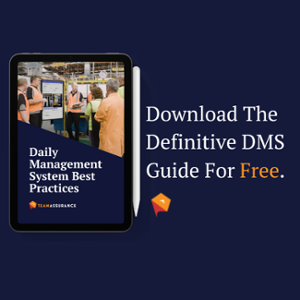Implementing Lean Tier Meetings: Practical Steps for CI Initiatives

Lean tier meetings are key to improved engagement and collaboration with your workforce. These daily huddles offer a structured platform for fostering continuous improvement. In this blog, we discuss a few practical elements of implementing lean tier meetings in your organisation, ensuring a successful (and impactful) rollout.
If you're wondering 'what is a tiered meeting?' We suggest you start by reading: Tiered Meetings are the first step to operational excellence.
Engage All Stakeholders
The first step towards implementing lean tiered meetings is recognising their importance and gaining buy-in from all stakeholders. Communicate the value of these meetings as a means to unlock the potential of your employees and improve customer satisfaction.
By highlighting the critical role of the frontline workforce in the success of the organisation, the support they require from all other levels, and how the management tiers will benefit you can build support and enthusiasm for the initiative across the entire organisation.
A tier meeting structure approach provides the following benefits (and more):
- Continuous improvement as BAU for all staff.
- Free flowing information horizontally and vertically throughout the organisation.
- Eliminating managerial bottlenecks and firefighting.
- Autonomous improvement activity at the frontline.
- Org-wide contribution and connection to strategy planning / execution.
Starting Lean Tier Meetings Require a People-First Approach
To kickstart lean tier meetings remember the lean principle 'respect for people'. Begin by encouraging employees to voice their frustrations and challenges. These are business losses. They are fully known about. Why would you not start here?
We dive into how to approach foundational tier meetings (and daily management) in this webinar below:
Create a safe space where they can share their experiences and contribute to problem-solving. By addressing these immediate concerns, you establish trust and show employees that their voices are heard and valued.

From here you can move to a no-blame culture where everyone takes responsibility for the success of your initiatives. This psychologically safe environment is crucial to sustained, meaningful tiered meetings.
Another of our webinars hosted by TeamAssurance CEO, Matt Mafrici, focuses on how to continue to build on this foundation to capitalise on synergy:
Your people are more likely to maintain a critical eye (and holistic perspective) on the processs and their own performance. They feel comfortable to share feedback knowing that it will have meaning, be backed by evidence and have impact.

Consider Methodology and Scalability of Systems
Develop a methodology that suits your organisation's unique needs and aligns with your continuous improvement goals. Keep the process simple, focusing on key measures and actionable steps.
Establish a clear framework for issue prioritisation, problem resolution, and communication channels. As you gain experience and success, scale up the number of issues addressed while maintaining control through efficient business processes. This is where a digital daily management system (DMS) is so useful - and why the best performing teams use them.
As the case study video above demonstrates, a DMS like TeamAssurance will enable you to easily embed best practices, capture data, and scale your continuous improvement. It keeps the information visible and supports data-driven decisions. This is communicated and actioned predominantly within the lean tier meeting.
Hence why these daily huddles are a foundational element of a daily management systems. It's the best tool for working on the business whilst working in the business. All the while keeping everything simple and every piece of info accessible for all your people.
A C.I. framework not locally optimised 'islands'
Lean tier meetings are just one element of the continuous improvement framework. It is still key to develop your problem solving techniques, Standard Operating Procedures (SOPs), and overarching Daily Management simultaneously. Achieving consistent progress through the PDCA loop requires standards and processes to not be developed isolation. Without considering all adjacent processes we can end up with misalignment of people, information silos, and sub-optimal procedures.
The illustration below demonstrates how we designed the interconnected TeamAssurance platform to avoid locally optimised, disconnected ‘Point Solutions’ (digital or analog) that do not help, and may even hinder the progress toward your goals.

If you’re a business in need (or a consultant with clients in need) and you'd like to explore the opportunities that digital-aids to Lean tier meetings provide contact us for a demonstration of the TeamAssurance platform today.
.jpg)
